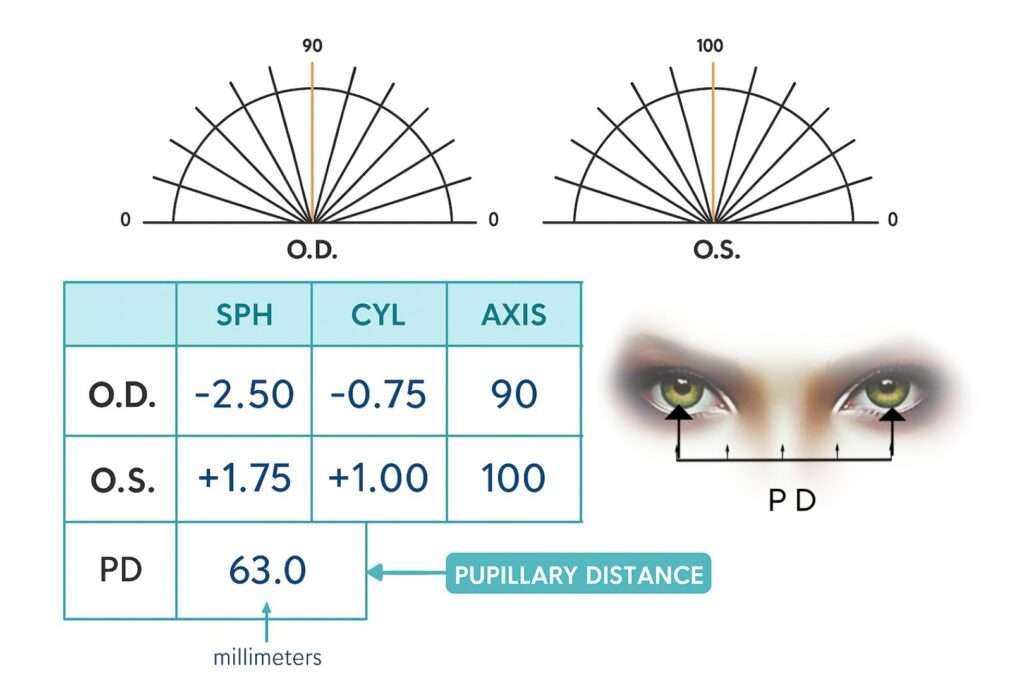A Complete Guide to Measuring Your Pupillary Distance (PD) at Home
When ordering glasses online, one of the most important yet often overlooked numbers is your pupillary distance (PD). This measurement ensures that the lenses align with your eyes, giving you the clearest vision possible. While your optometrist may provide it, many prescriptions leave PD out. The good news? You can measure it yourself at home with just a few simple tools.
In this guide, we’ll explain what PD is, why it matters, and provide a step-by-step method for measuring your own pupillary distance so you can confidently order glasses at Visionaryie.com.

What Is Pupillary Distance (PD)?
Pupillary distance is the measurement, in millimeters, between the centers of your pupils. It plays a critical role in how your lenses are placed in your frames. When lenses are centered correctly, you enjoy sharp, strain-free vision. If PD is incorrect, you may experience blurred vision, eye fatigue, or headaches.
PD can be:
Single PD: One number (e.g., 63mm) that represents the distance between both pupils.
Dual PD: Two numbers (e.g., 31/32mm), which measure each eye’s distance from the center of the nose.
Children’s PD values are generally smaller and change as they grow, which makes accurate measurements especially important when shopping for kids’ prescription glasses.
Why Accurate PD Matters for Online Glasses Orders
When you order prescription glasses online, the lenses are crafted based on your prescription and PD. If the PD is off by even a few millimeters, the lens alignment won’t match your eyes, making the glasses uncomfortable to wear.
Here’s why PD accuracy is so crucial:
Ensures lens clarity for all distances (reading, driving, computer use).
Prevents eye strain and headaches from misaligned lenses.
Allows progressive and bifocal lenses to work correctly.
Provides the same precision as in-store eyewear fitting.
In short, knowing your pupillary distance is just as important as knowing your SPH, CYL, or Axis values from your prescription.
Tools You Need to Measure PD at Home
Measuring your PD doesn’t require expensive equipment. You’ll just need:
A millimeter ruler (rigid, not flexible).
A mirror (for self-measurement).
A pen and paper (to note your result).
A friend or family member (optional, for more accuracy).
Step-by-Step Guide to Measuring Pupillary Distance
Method 1: Self-Measurement Using a Mirror
Stand about 8–10 inches away from a mirror.
Hold the ruler flat against your forehead, just above your eyes.
Close your right eye and align the ruler’s zero with the center of your left pupil.
Open your right eye, close your left eye, and read the measurement at the center of your right pupil.
Write down the result. This is your PD in millimeters.

Method 2: With a Helper
Sit comfortably and look straight ahead.
Ask your helper to hold the ruler against your forehead.
Keep your eyes focused on a distant object.
Have them measure from the center of one pupil to the other.
Repeat twice for accuracy.
Tip: If you wear glasses, you can mark the pupil centers on your lens with a washable marker, then measure between the marks.
Typical PD Ranges
Adults: 54mm – 74mm
Children: 43mm – 58mm
Your exact PD depends on your face size and eye spacing. Children’s PD needs regular updates since their eyes are still developing. That’s why accurate PD measurement is especially important when shopping from the kids’ prescription glasses collection.
How to Use PD When Ordering Online
Once you have your PD, ordering glasses becomes simple:
Update Your Prescription – Make sure it’s less than 2 years old.
Find Your Frames – Explore a wide selection of stylish options at the Prescription Glasses Collection.
Enter Prescription Details – Carefully fill in SPH, CYL, Axis, and Add if applicable.
Input PD – Add your PD value for correct lens alignment.
Choose Lens Enhancements – Consider anti-reflective, scratch-resistant, or blue light filter coatings.
Review & Confirm – Double-check numbers before placing the order.
Example of How PD Impacts Lenses
Imagine your PD is 62mm, but you accidentally enter 66mm when ordering online. The lenses will be slightly shifted outward, causing eye strain when reading or working on a computer. Over time, this misalignment could make the glasses feel unusable.
With the correct pupillary distance, however, your lenses will align perfectly, making your new glasses comfortable and effective.
Additional Tips for Measuring PD
Take 2–3 measurements and use the average for accuracy.
Always look straight ahead, not at the ruler.
For bifocals or progressives, ask your optician for a near PD (slightly different from distance PD).
If unsure, most opticians can provide your PD upon request.
Conclusion
Your pupillary distance may seem like a small number, but it has a big impact on how well your glasses work. By learning to measure PD at home, you ensure your lenses are perfectly aligned, giving you sharp vision and all-day comfort.
Whether you’re buying for yourself or your child, accurate PD ensures your glasses fit properly and work as intended. With this guide, you can measure confidently and shop with ease at Visionaryie.com.

